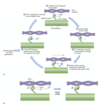Muscle Physiology - skeletal Flashcards
(35 cards)
- What type of muscle is shown in picture?
- Strength?
- Speed?
- Voluntary or involuntary?
- Appearance?

- Skeletal
- Strong
- Quick
- Voluntary
- Striated, large long fibers with many peripheral nuclei
- What type of muscle is shown in picture?
- Strength
- Speed
- Voluntary or involuntary?
- Appearance?

- Weak
- Slow
- Involuntary
- No striations, small cells with central nuceli
- What type of muscle is this?
- Strength?
- Speed?
- Voluntary or involuntary?
- Appearance?

- Cardiac
- Strong
- Quick
- Involuntary, short, thick fibers with 1-2 central nuclei, striated


A skeletal muscle fiber (cell) is derived by merging 100s-1000s of […]
Myofibrils
- How man nuclei are in skeletal muscle fibers?
- Where are the nuclei located?
- Many
- In periphery of myofibrils


Do the filaments of the sarcomere shorten during muscle contraction?
NO - neither thick no thin shorten. Rather, the bands of the sarcomere shorten due to increased overlap between the thick and thin filaments.
What part(s) of the sarcomere shortens during contraction?
The I-band and the H-zone
What part of the sarcomere does not shorten during contraction?
The A band
The I-band is primariy […] filaments, aka […].
Thin filaments
Actin
The A-band is primarily […] filaments, aka […]
Thick
Myosin
What band of the sarcomere is only thick filaments?
H-band
The Z-line is the anchor for […] filaments and the M-line is the anchor for […] filaments.
Thin
Thick
What is titin? Where is it located in the sarcomere?
Titin is in the I-band with the thin filaments. It helps prevent overstrecthing of the sarcomere


Is this muscle relaxed or contracted?

Contracted
Is this muscle relaxed or contracted?

Relaxed
Describe the structure of the thick filaments.

Describe the structure of the thin filaments.

Describe the structure and function of the troponin complex.

Describe the contractile mechanism cross-bridge cycle.

In relaxed skeletal muscle, what state of the cross-bridge cycle are muscle fibers in?
The “cocked” and energized position so that they are ready and waiting to bind to actin when Ca2+ moves tropomyosin out of the way
What is rigor mortis?
During death, intracellular Ca2+ stores are released, causing exposure of myosin binding sites on actin filaments so energized myosin cross-bridges can bind to actin and perform the power stroke. However, there is not enough ATP in the body to release the myosin from the actin so the muscles remain contracted.






